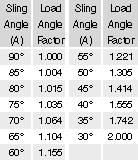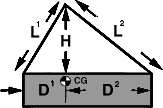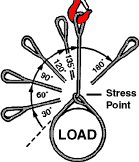 |
|
|
|
 |
|
|
|
Load Angle Factor = L / H
|
|
|
|
|
|
|
|
 |
|
 |
|
|
Load On Each Leg of a Sling (L1) =
|
|
Load (lbs.) x Load Angle Factor
Number of Legs*
|
|
|
| *See also three and four leg slings below |
|
|
|
|
|
 |
|
 |
|
|
|
|
|
|
| To calculate the load on each leg of a sling with unequal legs: |
 |
|
Load on Leg L1 =
|
Load (lbs) x D2 x L1
H x (D1 + D2)
|
|
Load on Leg L2 =
|
Load (lbs) x D1 x L2
H x (D1 + D2)
|
|
|
|
|
Triple leg slings have 50% more capacity than double legs only if the center of gravity is in the center of the connection point and the legs are adjusted to share the load equally. |
|
|
Rigging a Quad leg sling so that all legs share the load equally is very difficult. Therefore, when adjusting the working load limit of four leg chain slings, the number of legs in the calculation must be 3 not 4. Many riggers follow this model for quad leg slings of any material, relying on the fourth leg for stability only. |
|
|
|
|
|
|
 |
|
|
| Choke Angle - When lifting or turning a load rigged with a choker hitch, the angle at which a sling is turned back on itself can reduce it's capacity below what is listed for its choker hitch, if the angle is too severe. When a load is allowed to hang free, the natural choke angle is about 135°. |
 |
 |
| If the angle is less than 120°, you must adjust its Choker Hitch Working Load Limit by the appropriate choke factor from this table. |
|
Choker Hitch WLL x Choke Factor = Adjusted WLL
|
|
|
| Choker Hitch Rated Capacity - A choker hitch will have 75% of the capacity of a single leg vertical hitch only if the corners are softened and the horizontal angle is greater than 30°. |
 |
|
Use blocks to prevent angles less than 30°.
|
|
|
|
|
|
|
|
 |
|
 |
|
|
 |
|
|
|
|
|
|
|
|
|
|
|
|
|
|
|

